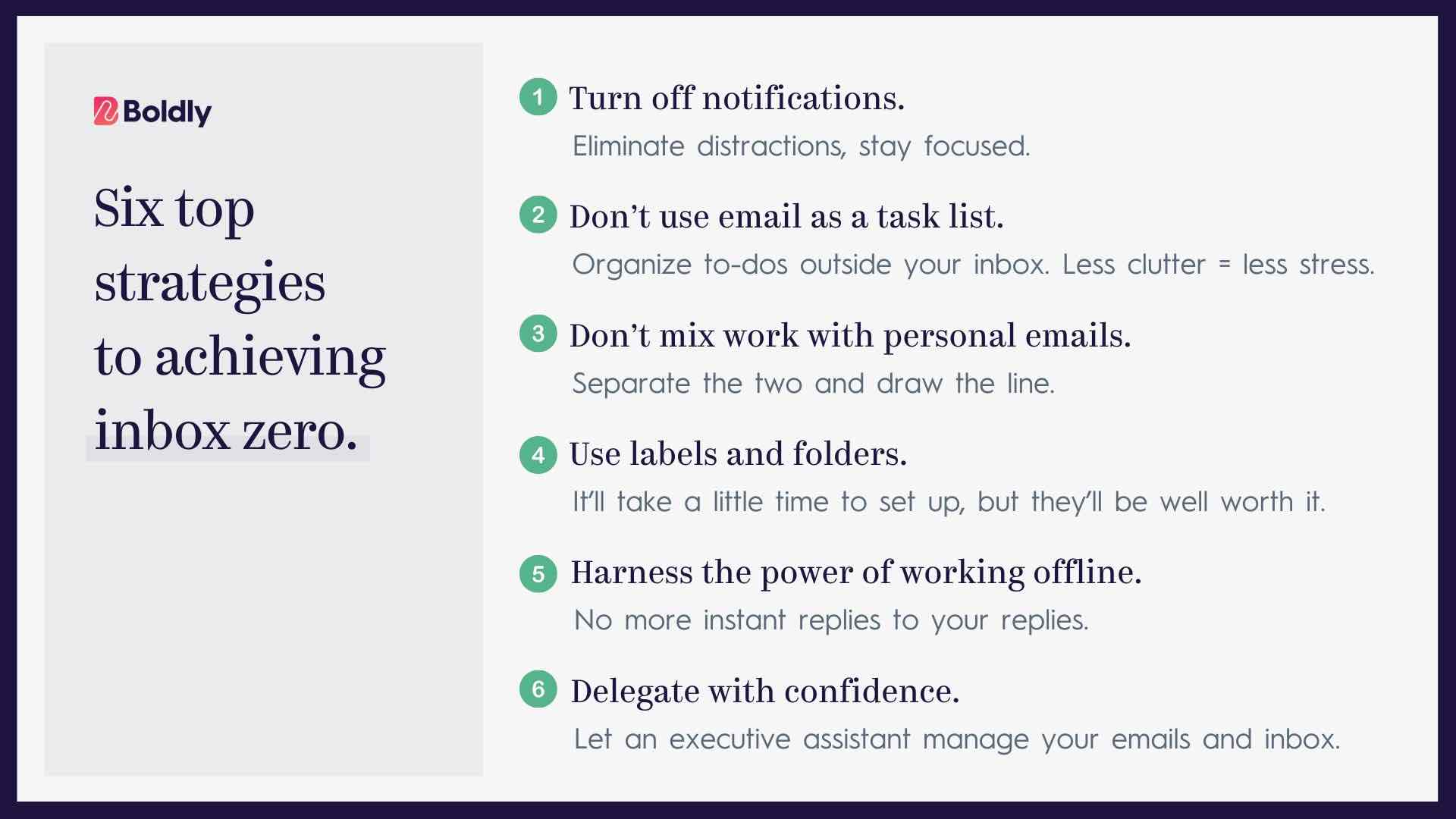Inbox zero — is it worth the effort?
After working with thousands of executives for over a decade, we know it is. Plus, we’ll share six practices to achieve and maintain this mountaintop of productivity, focus, and peace of mind.
Read also: The Best Apps to Help You Manage Email Overload
Six Practices For Inbox Zero Mastery
- Turn Off Notifications
- Don’t Use Your Email As A Task List
- Don’t Mix Work With Personal Emails
- Use Labels And Folders
- Harness The Power Of Working Offline
- Delegate With Confidence


Turn Off Notifications
The notification noise that exists within every email client and app – while useful at times – can be harmful to reaching those low inbox numbers.
Turning off notifications is a power move for successful inbox management, especially when you’re dealing with a full inbox to begin with!
This aligns with the inbox zero method, by helping you avoid communication overload and maintain focus.
While this may sound counter-productive, the arrival of the email ping or little envelope at the bottom of your computer screen immediately causes you to head to your inbox, ripping into whatever task you were doing.
Spending twenty minutes on an email each time it comes in will have a knock on effect on ALL of your work; emails interrupt tasks, which don’t get done within the time frame you had planned. Instead of dealing with emails as they arrive, have a few dedicated times to spend on them each day; it is far more constructive and your inbox will thank you.
Don’t Use Your Email As A Task List
Emails do contain tasks, projects, and assignments, but using them as a task list isn’t helpful.
It can certainly help you to draw up a to-do list, but this should be on a notebook or in a productivity app rather than your inbox.
Using your email list as a to-do list can create confusion and a disorganized workday as it isn’t designed to be a coherent project management list. In the quest for an emptier inbox, emails can get moved around and a task can be easily forgotten if this is your sole place for organization.
Instead, organize your tasks outside your email to boost email organization. A clutter-free inbox is a stress-free inbox.
Don’t Mix Work And Play
It’s easy to do this one, many people do. Perhaps a family member emails you at work on their lunch hour, or you contact a friend about work advice from your personal email.
Not only is this interfering with your day and wasting time when you should be working, but it is mixing work with play which isn’t going to be helpful in the quest for an emptier inbox.
Separate the two and draw the line; your inbox will be a much more organized place because of it. So treat work and personal emails like oil and water.
Use Labels And Folders
Folders are a key organizational system for your inbox, but they have to be super-systematized to function well.
Labels and folders are the path to make inbox zero the norm.
Don’t just have individual folders for a specific person or project, create practical sub-folders that will help you find emails at a later date, such as ‘Funding for the NY Project’, ‘February Meeting’, or ‘Travel’.
In doing so, your emails when received and responded to can be designated to a sensible and methodical destination without simply sitting in your inbox.
Harness The Power Of Working Offline
One of the reasons inbox zero isn’t achieved is that people are replying as you’re replying. That’s great, yes, but will it help if you’re trying to reach the end of emails that have already come in that day?
If you usually concentrate on the day’s email at home after the work day has ended, turn your email client into offline mode and respond to the emails. They’ll form an orderly queue in the outbox, and as soon as you go back online they’ll head out in one go. Then, shut off your computer and leave emails until the next day. Inbox zero is achieved, even if it is just for a short period of time.
This strategy is gold.
Delegate With Confidence
Gallup found CEOs with high delegation skills generate 33% more revenue than those with “low or limited levels” of this key leadership skill.
The high achievers know they can’t accomplish everything themselves. That’s why they gave up control, making time for the highest return activities.
The truth is, you cost your company far too much to manage your email.
That’s why the simplest inbox zero hack is delegating email management altogether! And statistically, it pays dividends on company performance.
Enter the solution: a ridiculously talented executive assistant for leaders in absurdly crucial roles (like you).
Because today’s top executive assistants are more than masters of admin. They’re strategic partners senior execs can’t afford to work without.
Read more: Should Your Executive Assistant Have Access To Your Email?
And since we know the key to delegate your inbox with confidence is trust, we’d love to offer you a no-strings-attached conversation that could have you to inbox zero — and unparalleled productivity — in as few as 3 days.
Inbox zero is achievable. It’s worth it. But we think your strategic time and energy is worth more than doing it yourself.
Let’s talk about how we can help skyrocket your leadership effectiveness — friction-free.




